Czichos H., Saito T., Smith L.E. (Eds.) Handbook of Metrology and Testing
Подождите немного. Документ загружается.

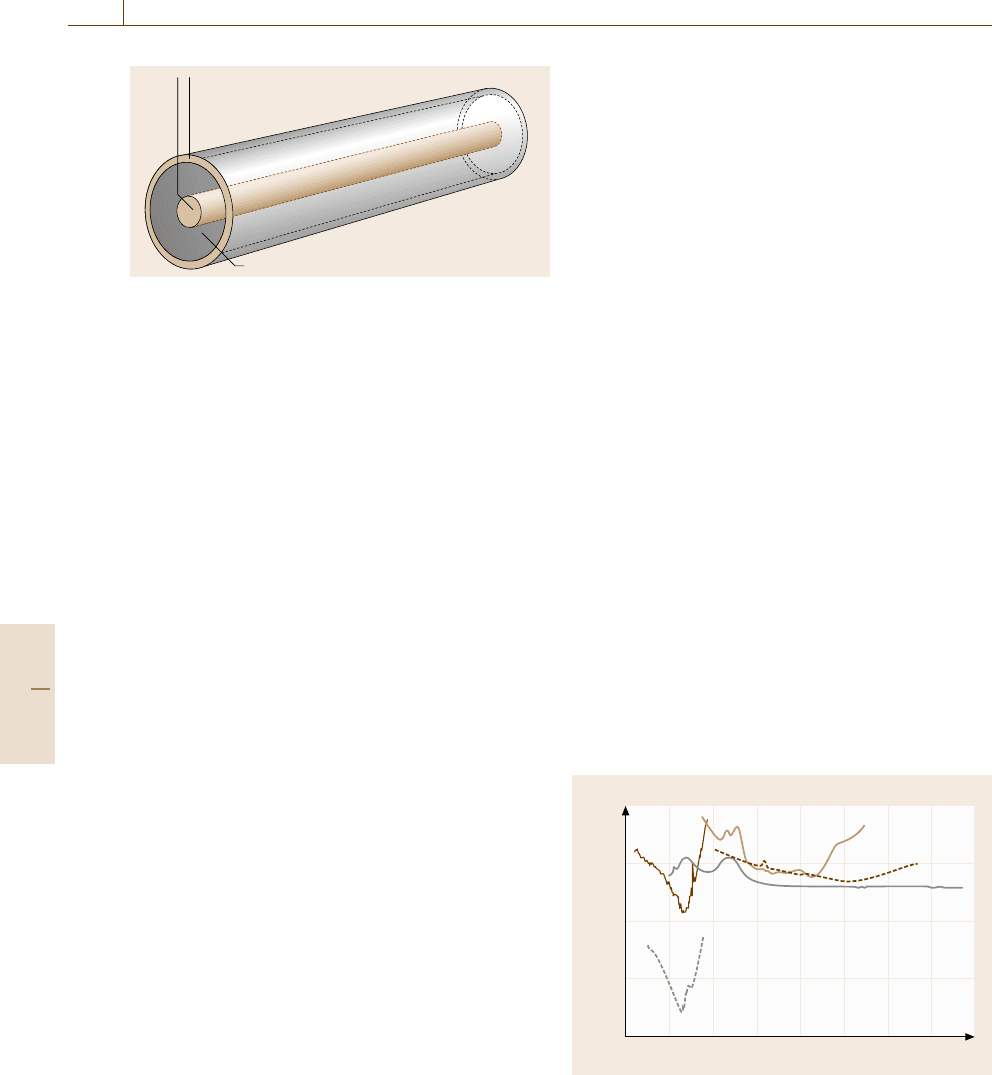
638 Part C Materials Properties Measurement
Outer claddingCore
Inner cladding
Fig. 11.78 Schematic drawing of a double-clad fiber
Cladding-pumped fiber lasers accommodate high-
power multimode pump sources, but can still produce
a single-mode output. In the last decade various pump-
ing schemes, such as star-coupler pumping [11.124],
V-groove pumping [11.125] and side-coupler pump-
ing [11.126, 127], have been developed to increase the
available count of multimode pump sources in addi-
tion to the simple end-pumping approach [11.128,129].
Cladding-pump technology has drastically increased the
output power of fiber lasers to well over 100 W even in
single-mode operation and seems likely to surpass bulk
lasers in many industrial application areas.
11.5.5 Miscellaneous Fibers
In addition to silica-glass-based fibers, many kinds of
optical fibers have been developed for various applica-
tions, such as local area networks, laser power delivery
and optical sensing. In this section, most viable and
commercially available fibers are reviewed.
Infrared Fibers
Infrared fibers, defined as fiber optics transmitting radi-
ation with wavelengths greater than 2 μm are divided
into three categories, i. e., glass, crystalline, and hol-
low waveguides. Figure 11.79 shows the optical loss for
the most common infrared fibers [11.135]. In general,
both the optical and mechanical properties of infrared
lasers are inferior to those of silica-based fibers, and
the use of infrared fibers is still limited to applications
in laser power delivery, thermometry, and chemical
sensing.
HMFG Fibers. Heavy-metal fluoride glass (HMFG),
most commonly, ZrF
4
–BaF
2
–LaF
3
–NaF (fluorozir-
conate, ZBLAN) and AlF
3
–ZrF
4
–BaF
2
–CaF
2
–YF
4
(fluoroaluminate) presents a low optical loss around
2.5 μm [11.130]. The attenuation in HMFG fiber is
predicted to be about ten times less than that for
silica fibers based on extrapolations of the intrinsic
losses resulting from Rayleigh scattering and multi-
phonon absorption [11.136]. ZBLAN is also a candidate
host material for various fiber amplifiers because of
the smoothed broadened spectra. However, their low
durability against moisture attack and poor mechanical
strength prevent their widespread use. The losses of flu-
oroaluminate fibers are not as low as for the ZBLAN,
but fluoroaluminate fibers have the advantage of higher
glass-transition temperatures and therefore are more
promising for the power delivery of Er:YAG laser wave-
length of 2.94 μm.
Germanate fibers. Heavy-metal-oxide glass fibers
basedonGeO
2
are an alternative candidate to HMFG
fibers for 3 μm laser power delivery because of a higher
glass-transition temperature (680
◦
C) and excellent
durability [11.137]. These fibers have a higher damage
threshold and can deliver laser powers over 20 W from
Er:YAG lasers.
Chalcogenide fibers. Chalcogenide glass fibers are
classified into three categories: sulfide, selenide ,and
tellulide. One or more chalcogen elements are mixed
with one or more elements such as As, Ge, P, Sb, Ga to
form a glass. Chalcogenide glasses are stable, durable,
and insensitive to moisture. Generally, the glasses have
a low softening temperature and a rather large value of
dn/ dT. This fact limits their laser power-handling ca-
pability, and the fibers are considered to be a promising
candidate for evanescent-wave fiber sensors and in-
10
1
0.1
0.01
0.001
Wavelength (μm)
0 2 10 12 14 16
Loss (dB/m)
Sapphire
Fluoride glass
Chalcogenide
AgBrCl
Hollow glass
waveguide
468
Fig. 11.79 Loss spectra for some common infrared fiber
optics: ZBLAN fluoride glass [11.130], single-crystal sap-
phire [11.131], chalcogenide glass [11.132], polycrys-
talline AgBrCl [11.133], and a hollow-glass waveguide
[11.134] (after [11.135])
Part C 11.5

Optical Properties 11.5 Fiber Optics 639
frared fiber image bundles. The loss spectra for the most
important chalcogenide fibers, AsGeSeTe [11.132] are
showninFig.11.79.
Crystalline fibers. Sapphire is an extremely hard, robust
and insoluble material with an infrared transmission
region from 0.5 to 3.2 μm and a melting point of
over 2000
◦
C. These superior physical properties make
sapphire the ideal infrared fiber candidate for applica-
tions at wavelengths less than 3.2 μm. The disadvantage
of sapphire single-crystal fiber is fabrication difficulties.
Fiber diameters range from 100 to 300 μm and lengths
are generally less than 2 m. The loss spectra of sap-
phire fiber [11.131]areshowninFig.11.79. Fiber loss
is less than 0.3dB/m at the Er:YA G laser wavelength of
2.94 μm, and the fibers are used to deliver over 10 W of
average power. Sapphire fiber can be used at tempera-
tures up to 1400
◦
C without any change in transmission.
Halide crystals have excellent infrared transmission,
especially in the longer wavelength region. However,
only the silver and thallium halides have been success-
fully fabricated into fiber optics, using a hot extrusion
technique. In the hot extrusion process, a single-crystal
perform is placed in a heated chamber at a temperature
equal to about half the melting point, and the fiber is
extruded to a fiber shape through a diamond or tung-
sten carbide die. The fibers are usually 900–500 μmin
diameter. The loss spectra of polycrystalline AgBrCl
fiber [11.133] are shown in Fig. 11.79. The loss at
10.6 μm can be as low as 0.2dB/m and the transmission
band extends up to about 20 μm.
Hollow glass waveguides. Previously, hollow waveg-
uides were formed using metallic and plastic tubing.
Today, the most popular structure is the hollow glass
waveguide (HGW). The advantage of glass tubing is
that it is much smoother than either metal or plastic
tubing. HGWs are fabricated using a conventional wet
process first to deposit a layer of Ag film on the in-
side of silica glass tubing, and then a dielectric layer
of AgI is formed over the metallic film by converting
some of the Ag to AgI. The thickness of the AgI is
optimized to give high reflectivity at a particular laser
wavelength [11.138]. The spectral loss for an HGW
with a 530 μm bore, which is optimized for a wave-
length of 10 μm [11.134], is shown in Fig. 11.79. HGWs
have been used successfully in infrared laser-power de-
livery and some sensor applications. CO
2
and Er:YAG
laser power below about 80 W can be delivered without
difficulty. Employment of water-cooling jackets fur-
ther increased the handlable laser power up to about
1 kW [11.139].
More detailed information on infrared fibers can be
found in the literature [11.140].
Plastic optical fiber. Plastic optical fibers are com-
mercially available for local-area networks, sensing use,
and illumination. Conventional plastic optical fibers
are multimode fibers with a large core diameter of
about 1000 μm and are made of polymethyl methacry-
late (PMMA). Figure 11.80 shows the transmission
loss of the plastic optical fibers as a function of
wavelength [11.141]. The transmission loss reaches
a minimum value of about 100 dB/km around the spec-
tral region between 500 and 600 nm. Usually, signal
transmission lines of plastic optical fibers use 650 nm
light-emitting diodes and the transmission distance is
limited to 50 m because of the relatively high transmis-
sion loss (160 dB/km).
Recent development of perfluorinated plastic optical
fibers significantly improved the transmission charac-
teristics of plastic optical fibers in the spectral region
from visible to 1300 nm because the perfluorinated
polymer has no C–H bond in its chemical structure. The
specific loss at a wavelength of 850 nm is 17 dB/km.
Signal transmission at 2.5Gb/s was conducted over
144 m perfluorinated graded-index plastic optical fiber
with an 850 nm vertical-cavity surface-emitting laser
(VCSEL) transceiver [11.142].
Photonic Crystal Fibers
The photonic band gap concept triggered the devel-
opment of photonic crystal fibers [11.143, 144]. Since
the first fabrication of photonic crystal fiber (PCF)in
1995 [11.145], a sequence of innovations has been
500
400
300
200
100
0
400 450 500 550 600 650 700
Wavelength (nm)
Loss (dB/km)
Fig. 11.80 Transmission loss in plastic optical fiber
Part C 11.5
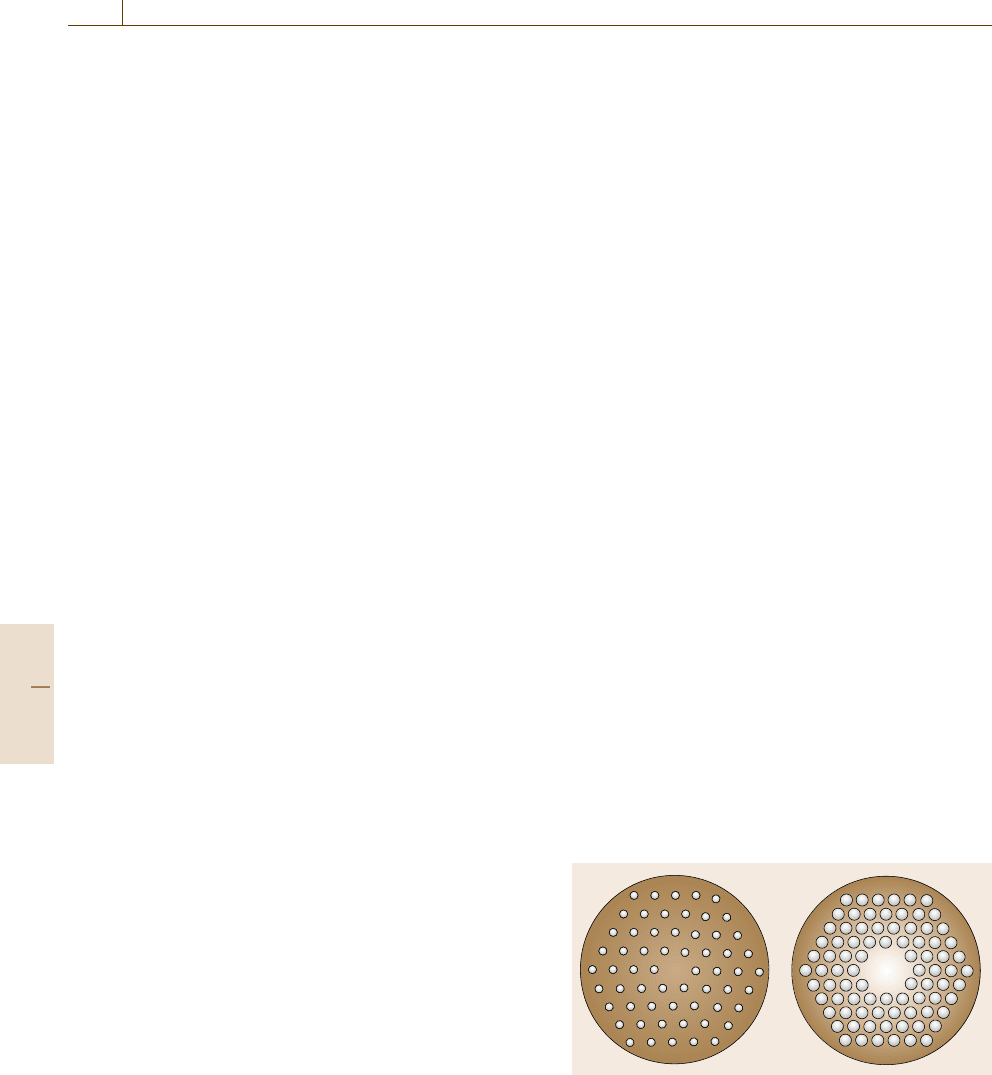
640 Part C Materials Properties Measurement
achieved in fiber optics technology. The remarkable
properties of PCF have overturned many of the key pre-
cepts of textbook fiber optics. The enormous potential
offered by this new structure may make current fiber
optic technology obsolete.
PCFs are optical waveguides in which a microstruc-
tured cladding confines light to the fiber core. Unlike
conventional all-solid fibers, which guide light by the
total internal reflection at the core–clad interface, the
new structures provide great freedom to control the
characteristics of the fibers.
PCFs are divided into two categories based on the
principal mechanism by which light is confined to the
core. One of these is a species of total reflection, and
the other is a new physical effect – the photonic band
gap. Those typical structures are shown in Fig. 11.81.
The first type of PCF usually has a silica core
surrounded by the air hole, as shown in Fig. 11.81a.
Optical confinement is achieved when the effective
(area-averaged) refractive index is lower in the cladding
region than in the core.
Figure 11.81b shows the structure of the photonic
band gap and hollow-core PCF. The guiding mechanism
relies on the coherent backscattering of light into the
core. This effect, which is based on the photonic band
gap (PBG), allows fiber to be made with hollow core.
PCF can be made by stacking tubes and rods of
silica glass into a structure that is a macroscopic pre-
form of the pattern of holes required in the final fiber.
The typical dimension of this preform is 1 m long and
20 mm in diameter. The preform is then introduced into
the furnace of a fiber-drawing tower.
Index-Guiding PCF
Large core. Light can be guided in PCFsbyembed-
ding a region of solid glass enclosed by an array of
air holes. This approach has several important appli-
cations, and an excellent introduction is available in
the review [11.146]. Index-guiding PCF provides new
opportunities that stem from the special properties of
the photonic crystal cladding, which are caused by the
large refractive index contrast and the 2-D nature of the
microstructure. These affect the dispersion, smallest at-
tainable core size, the number of guided mode and the
birefringence in a different way to conventional silica
fiber.
For example, endlessly single-mode PCF can be
made with a very large core area [11.147, 148]. In con-
trast with conventional fibers, single-mode operation is
guaranteed in solid-core PCF whatever the overall size
of structure – in particular for large core – provided that
the ratio of hole-diameter to spacing is small enough.
Ultra-large mode area PCF may have applications in
high-power transmission and high-power lasers and am-
plifiers [11.149].
Small core. In contrast, if the holes are enlarged
and the overall scale of the structure reduced so that
the solid core is ≈ 0.8 μm in diameter (ultra-small
mode), the zero-dispersion wavelength can be 560 nm
in the green. This is quite different from the zero-
dispersion wavelengths in conventional silica fibers.
In fact, the group velocity dispersion can be radically
affected by pure waveguide dispersion in fibers with
small cores and large air holes in the cladding [11.150].
Another feature of fibers with ultra-small mode area
is that the intensity of light attainable for a given
launched power is very high, so nonlinear optical
effects can be easily obtained. With a fiber with
a small core and a zero-dispersion wavelength around
800 nm, femtosecond pulses from a Ti:sapphire laser
was efficiently converted to a single-mode broadband
optical continuum [11.151], which is already being
used in frequency metrology [11.152], optical coher-
ence tomography [11.153] and spectroscopy. Enormous
birefringence that exceeds values attained in conven-
tional fibers by an order of magnitude, have already
been achieved in PCFs [11.154].
Hollow-Core Photonic Band Gap Fibers
In 1999, the first hollow-core photonic band gap fiber
was drawn from a stack of thin-wall silica capillaries
with an extra large hole in the center, which was formed
by omitting seven capillaries from the stack [11.155].
The strong wavelength dependence of guiding indicated
a photonic band gap effect: only certain wavelength
a) b)
Fig. 11.81a,b Two different designs of PCF. (a) shows
a single-mode fiber with a pure silica core surrounded by
a reduced-index photonic-crystal cladding material,
(b) is
an air-guiding fiber in which the light is confined to a hol-
low core by the photonic-band-gap effect
Part C 11.5

Optical Properties 11.6 Evaluation Technologies for Optical Disk Memory Materials 641
ranges fall within the band gaps and are guided, while
other light quickly leaks out of the hollow core.
The most important factor for any fiber technology
is loss. Loss in conventional fibers has been reduced over
the past 30 years and seems to be approaching the mater-
ial limit. However, losses in hollow-core photonic band
gap fibers might be reduced below the levels found in
conventional fibers because the majority of the light trav-
els in the hollow core, in which scattering and absorption
could be very low. Confinement losses can be elimi-
nated by forming a sufficiently thick cladding. However,
increased scattering at the many surfaces is a poten-
tial problem. The lowest attenuation reported to date
for hollow-core photonic band gap fiber is 1.7dB/km
[OFC-PD] [11.156], and is still an order of magnitude
higher than that of conventional state-of-the art silica
fibers, 0.15 dB/km [11.157]. The dramatic reduction of
loss over the past few years suggests that it will be
reduced still further. Dispersion is far lower than in solid-
core fibers. Group velocity dispersion (GVD)inthese
fibers – a measure of their tendency to lengthen a short
pulse during propagation – crosses zero within the low-
loss window, and is anomalous over much of the wave-
length band. This implies that these fibers could support
short-pulse propagation as optical solitons. The Kerr
nonlinearity of the hollow-core fiber was low because it
was filled with gas, whereas the effects of Raman scat-
tering were eliminated by filling the fiber with xenon.
Hollow-core fibers exhibited a substantially higher dam-
age threshold than conventional fibers [11.158], mak-
ing them suitable for delivery of high-power beams for
laser machining and welding. 200-fs 4-nJ pulses from
a Ti:sapphire laser have been transmitted through 20 m
of hollow-core fibers with a zero-GVD wavelength of
850 nm, and the autocorrelation width of the output pulse
was broadened to roughly 3.5 times the input pulse,
partly due to the modest spectral deformation [11.159].
Further improvement is expected by working away from
the zero-GVD wavelength. Hollow-core fibers seem to
have massive potential.
11.6 Evaluation Technologies for Optical Disk Memory Materials
Two types of rewritable optical disks are well-known
today. One is a phase-change optical disk that utilizes
the phenomenon of optical changes that accompany
the reversible phase transitions between amorphous
and crystalline states. Utilizing phase-change materials,
various rewritable optical disks such as DVD-RAM,
DVD-RW, CD-RW and blu-ray discs have been com-
mercialized. The other is a magnetooptical (MO) disk
that utilizes the polar Kerr effect. It is known that the
polarization plane of linearly polarized light revolves
slightly when it is reflected from a perpendicularly
magnetized magnetic film. MO disks have also been
commercialized as various office tools and as the Mini-
Disc (MD) for audio use. In this section, the evaluation
technologies for a phase-change material are first ex-
plained, and those for an MO material follow. For each
case, evaluation technologies are mainly described from
two points of view: the material property itself and the
device property that uses the memory material. As de-
scribed below, the the properties of the two materials
are very different, while the second aspect is generally
common. Strictly speaking, various drive technologies
such as servo technology and optics etc. are necessary to
carry out sufficiently precise evaluations. However, the
essence of them will be understood by the descriptions
here.
11.6.1 Evaluation Technologies
for Phase-Change Materials
To evaluate phase-change memory materials, knowing
their thermal and optical characteristics is essential.
This is because i) the optical change is dominantly and
directly determined by the change of optical proper-
ties of the phase-change films, and ii) the phase-change
mechanism is typically a thermal process. It is also very
important to examine the thermal and optical proper-
ties of additional layers such as transparent protection
layers composed of dielectric materials and reflection
layers composed of metallic materials. The typical
layer structure of a phase-change optical disk is shown
in Fig. 11.82. Accordingly, practical optical disk char-
acteristics can be estimated by knowing the thermal and
optical characteristics of all these films. However, the
evaluation technology is limited to the phase-change
materials themselves due to space restriction.
Research and Development History
of Phase-Change Materials
Today, many phase-change optical disks have been put
to practical use. Without exception, they have adopted
chalcogenide films for their memory layers. Study of
chalcogenide alloys started in Russia in the 1950s.
Part C 11.6

642 Part C Materials Properties Measurement
Cover layer
Substrate
Phase-change
memory layer
Protection layer
UV-resin layer
Protection layer
Fig. 11.82 Cross section of a typical layer structure of
phase-change optical disk with four layers
Kolomiets et al. found that various chalcogenide al-
loys, such as Tl–Te and Tl–Se, could be easily vitrified
and the obtained glassy substance showed semiconduc-
tor properties [11.160]. These new glass materials were
named dark glass in contrast to the conventional trans-
parent oxide glasses, and they were generically called
chalcogenide glass semiconductor in the 1960s.
Ovshinsky’s group first demonstrated the great po-
tential of these glass materials as optical memories. In
1971, Feinleib et al. reported that a short laser pulse in-
duced instant and reversible phase changes on a chalco-
genide glass semiconductor thin film, representatively
Te
81
Ge
15
Sb
2
S
2
[11.161]. This result aroused large re-
search and development (R&D) activities all over the
world at the beginning of the 1980s, and various mater-
ials, especially Te-based eutectic alloys, were studied
towards the beginning of the 1980s [11.162–165].
However, these Te-based eutectic compositions
have not ultimately resulted in practical use, and R&D
activities on phase-change optical memories declined
in the mid-1980s. This is because conventional chalco-
genide glass materials had several fatal problems, such
as data rewriting speed and cyclability, for a rewritable
optical memory.
Under these circumstances, Yamada et al. proposed
the GeTe−Sb
2
Te
3
pseudo-binary material system
(hereinafter denoted by GeSbTe) based on a novel con-
cept [11.166]. The largest difference between GeSbTe
and the conventional materials is that GeSbTe is no
longer a chalcogenide glass but just a chalcogenide
while the conventional materials have characteristics
suitable for the name of chalcogenide glasses [11.167].
GeSbTe has solved the fundamental problems and real-
ized a very short crystallization time of several tens of
nanoseconds, more than 100 000 cycles of data rewrit-
ing, and tens of years of estimated life. It can be said
that this material created a new era for the R&D of
phase-change optical memories. The basic concept of
GeSbTe has been succeeded by other materials such
as AgInSbTe and Ge(Sb
75
Te
25
) −Sb etc. Those are
generically named Sb −Te [11.168, 169]. The latest
compositions being studied are Sb-based compositions
including Te [11.170].
Principle of Phase-Change Recording
The phase-change principle is explained in Fig. 11.83,
which shows the relation between the temperature and
free energy of a substance. Molten substance crys-
tallizes at the melting temperature (T
m
)whenitis
gradually cooled down while maintaining thermal equi-
librium. However, the molten substance sometimes does
not crystallize even though it is cooled below T
m
when
the cooling speed is sufficiently large. This is a su-
percooled state and it is frozen into a noncrystalline
solid called an amorphous state at a certain tempera-
ture (T
g
) that is intrinsic to a substance. Conversely, the
amorphous solid can be transformed into a crystalline
solid by heating it above T
g
for a period of time. The
amorphous solid then becomes a supercooled liquid and
crystallization occurs abruptly.
In order to achieve recording and erasing, it is neces-
sary to undergo the above thermal process on a revolv-
ing optical disk. For this requirement, a well-focused
laser beam is utilized. Figure 11.84 shows the heat pro-
file of a phase-change recording film of an optical disk
while the optical disk is passing through the laser beam.
In the figure, two curves show the temperature at the
center part of the track. When the laser power is strong
enough to melt the phase-change film instantly (a), the
temperature increases above T
m
as the disk approaches
Mol. volume (enthalpy)
Temperature
Melt-quenching
Annealing
Melt
Solid
Super-cool
Liquid
T
g
T
m
T
v
Produce changes in
optical, electrical,
thermal properties
Amorphous
Crystal
Vaporize
Fig. 11.83 Thermodynamical explanation of a phase-
change process
Part C 11.6
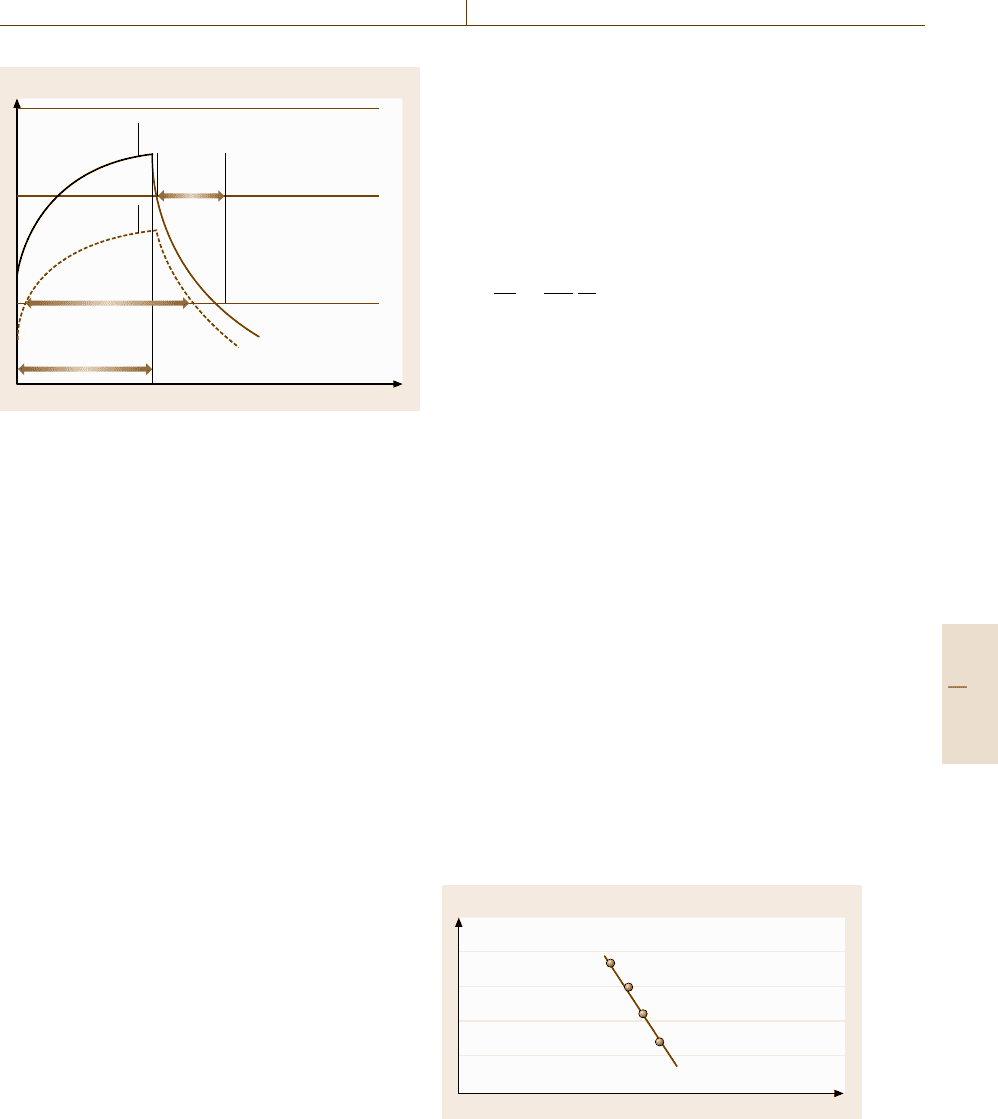
Optical Properties 11.6 Evaluation Technologies for Optical Disk Memory Materials 643
Time
Temperature
Melt-quenching
Annealing
Laser heating
Liquid
Super-cool
Solid
Crystal
Amorphous
T
v
T
m
T
g
a)
b)
t2
t1
d/v
Fig. 11.84a,b Schematic view of the thermal profile of
a laser-exposed area on an optical disk while it passes
through the laser spot
the laser beam, and decreases as the disk goes away
from the laser beam. By designing the heat capacity
of the recording film to be sufficiently small, and the
thermal diffusion rate from the recording film to the ad-
jacent films to be sufficiently large, the molten area can
be transformed into an amorphous state. On the con-
trary, when the laser power is not high enough to elevate
the film temperature over T
m
but high enough to ele-
vate it over T
g
(b), it is seen from the figure that the
period when the temperature is between T
g
and T
m
(t1)
becomes rather longer than the case of (a). Thus, the
exposed area is re-transformed into a crystalline state.
Fundamental Properties
of Phase-Change Materials
For the recording film of a phase-change optical disk, op-
tical and thermal properties are very important factors.
The former is tightly related to the quality of the record-
ing signal itself and the latter relates to the recording sen-
sitivity or thermal reliability. At first, the technologies
for obtaining the basic physical properties are described.
Melting Temperature T
m
, Glass Transition Tempera-
ture T
g
, and Crystallization Temperature T
x
. It is widely
known that the temperatures T
m
, T
g
,andT
x
are meas-
ured using differential scanning calorimetry (DSC)or
differential thermal analysis (DTA). It is generally said
that measurement results by DSC have higher accuracy
than with DTA. DTA is suitable for a measurement under
rather high-temperature conditions. For a preparation
of the specimens, phase-change films are deposited on
a glass substrate, scratched off and powdered. T
m
and T
g
are observed as endothermic peaks by these machines;
however, it is difficult to observe T
g
in the case of re-
cent high-speed phase-change materials. It is said that
T
g
does not appear for those materials since T
g
is higher
than T
x
. T
x
is observed as an exothermic peak. Because
T
x
shows a distinct dependence on the heating rate, the
activation energy can be obtained based on Kissinger’s
equation (11.122) as shown in Fig. 11.85.
ln
α
T
2
x
=
ΔE
R
1
T
x
+const. , (11.122)
where α, R, E and T
x
are the heating rate, gas con-
stant, activation energy and crystallization temperature,
respectively.
Therefore, by plotting ln α/T
2
x
versus 1/T
x
, an acti-
vation energy E can be obtained from the slope of the
graph [11.171,172]. Each value of T
m
, T
x
,andE closely
relates to recording sensitivity, thermal resistance of the
amorphous state, and crystallization speed under high-
temperature conditions.
There is another, optical method to measure T
x
,
which is shown in Fig. 11.86. In the case of a phase-
change material, phase-change phenomenon naturally
accompanydistinct optical properties. Accordingly, crys-
tallization temperatures can be measured by detecting
the temperature at which the optical properties, such as
transmittance and reflectivity, drastically change when
elevating the temperature of the film sample at a con-
stant heating rate. Optical changes can be detected for
example using a He–Ne laser. The greatest advantage of
the optical method is that a film sample can be used in-
stead of a powdered sample. Though it is reported that T
x
abruptly increases as the film thickness becomes thinner,
practical T
x
of an optical disk can be measured by this
optical method. Additionally, it is very important that
1/T
ln α/T
x
2
ΔE/R
Fig. 11.85 Schematic of a Kissinger plot from which the
activation energy E can be obtained as the gradient of the
line
Part C 11.6
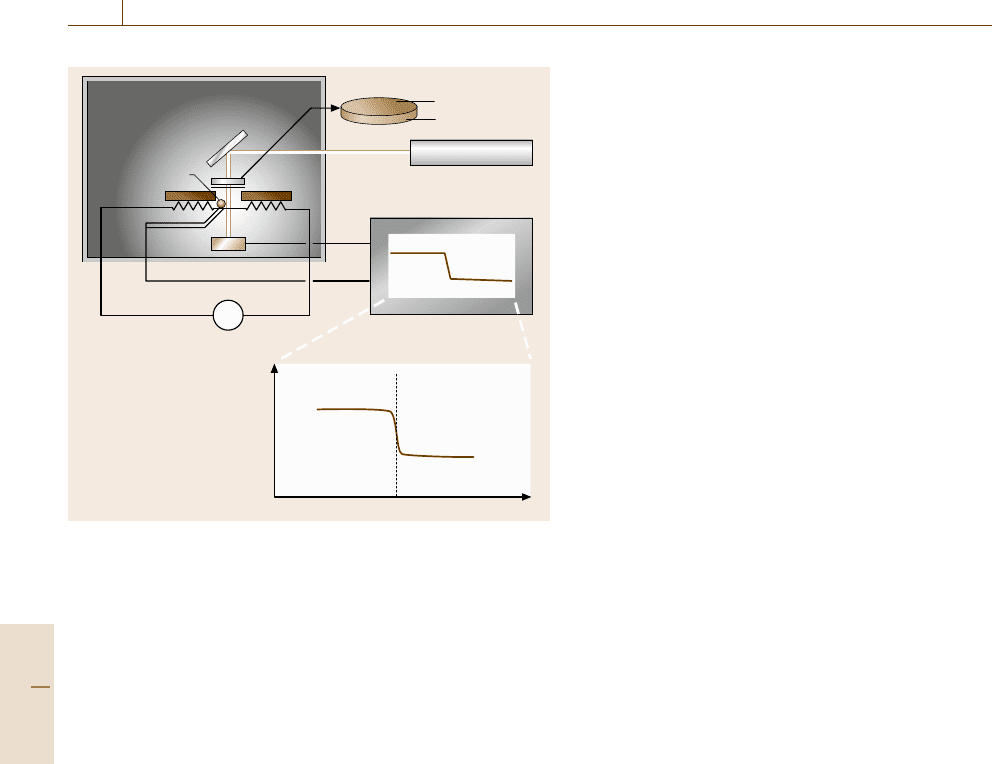
644 Part C Materials Properties Measurement
Mirror
Stage
He-Ne laser
XY-recorder
Chart
Dark box
Thermocouple
Sample
Heater
Sensor
Material film
Glass substrate
Power supply
V
Transmittance
Temperature
As-deposited
Crystallized
T
x
Fig. 11.86 Optical method for evaluating the crystallization temper-
ature T
x
of a phase-change thin film. The upper figure shows the
set-up and the bottom shows the obtained chart
this method drastically saves time for a sample prepara-
tion.
Optical Constants. It is intrinsically important for phase-
change optical materials to obtain their optical con-
stants: n (refractive index) and k (extinction coefficient).
Especially, obtaining them for wavelengths λ around
300–1000 nm is very important since laser diodes exist
in the range. With the constants both in the amorphous
and crystalline states, we can simulate the optical char-
acteristics when the materials are applied as the memory
layer of optical disks. They are, for example, reflectivity,
absorbance, transmittance and variations of these before
and after recording. To obtain these optical constants, we
can adopt a commercial ellipsometer. Since it is difficult
to obtain a large laser-quenched amorphous film, an as-
deposited film is usually substituted for an amorphous
sample. A crystalline sample is prepared by annealing
the as-deposited film in an Ar or N
2
gas atmosphere.
Optical constants can also be obtained by a cal-
culation method. Firstly, optical reflectivity parameters
(from both the film and substrate sides), transmittance
and film thickness are experimentally measured using
a spectrometer and a step-meter called a DEKTAK or
α-step, respectively. Secondary, sets of optical param-
eters are calculated by assuming values for the optical
constants n and k based on the matrix method [11.173].
The measured and the calculated parameters are com-
pared, and the assumed optical constants giving the
smallest error are selected as the real values.
Crystallization Speed. Data-rewriting speed is as impor-
tant a factor as recording capacity for memory devices.
In the case of phase-change memory, data-rewriting
speed is dominated by the crystallization speed. Since it
is difficult to measure the crystallization speed directly,
the evaluation of the crystallization speed is usually
substituted by the required laser exposure duration that
causes crystallization. The laser exposure duration can
be calculated from the disk revolving speed v and the
laser beam size d (laser wavelength and NA of the ob-
jective lens) on a real dynamic tester as d/v;however,
a static tester is applied in order to simulate the response
under a wider range of laser exposure conditions.
Figure 11.87 shows a representative set-up of a static
tester and a coupon-size specimen [11.174]. On the static
tester, laser exposure from a laser diode (LD) is car-
ried out with varying laser power and exposure duration
on the coupon specimen. For a detection of the expo-
sure results, a sufficiently weakened laser beam is re-
exposed and the variations are observed as the reflectiv-
ity changes. Here, it is very important that the specimen
has a similar layer structure as the practical optical disks.
Accordingly, dynamic properties such as crystallization
time and amorphization sensitivity can be simulated on
the static tester. For example, we can determine whether
the materials are applicable to DVD-RAM by inves-
tigating whether their crystallization times are faster
than 80 ns. The recording–erasing conditions of DVD-
RAM are: revolving speed v = 8.2m/s, laser beam size
d = 0.66 μm(1/e), calculated effective exposure dura-
tion of d/v =80 ns. In the case of the GeTe−Sb
2
Te
3
pseudo-binary system, one of the most well-known ma-
terials, the obtained crystallization time is as short as
30 ns, and it is known that this material system can be
used as a memory layer for DVD-RAM [11.175].
Instrumental Analyses. For characterization of phase-
change materials, various instrumental analyses are uti-
lized. Firstly, averaged film compositions are examined
using a x-ray micro analyzer (XMA), an electron-probe
microanalyzer (EPMA) and inductively coupled plasma
(ICP). XMA and EPMA can detect the contained ele-
ments in a microscopic area on a film sample, although
the accuracy is not as high as for ICP. On the other hand,
ICP can obtain very precise composition values. The
weak points of ICP are that it is not suitable for detecting
Part C 11.6
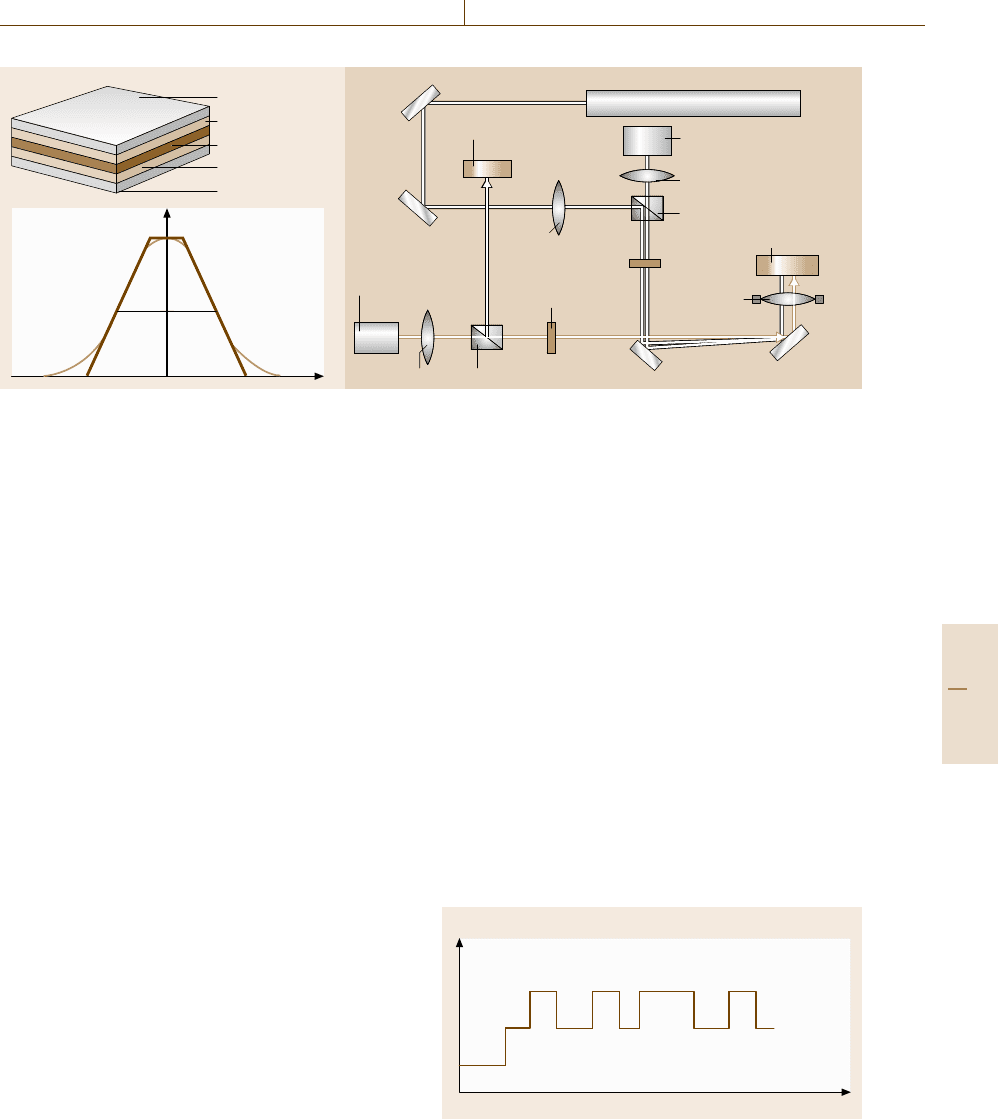
Optical Properties 11.6 Evaluation Technologies for Optical Disk Memory Materials 645
PMMA
PMMA
Protection layer
Phase-change film
Protection layer
1
0.5
0
Mirror
Mirror
Mirror Mirror
Laser diode
Lens L1
Lens L2
Lens L3
Lens L4
Beam splitter
Beam splitter
Specimen
Photo-detector
for focussing
PIN photo-diode
He-Ne laser
λ/4 plate
λ/4 plate
Fig. 11.87 Optical set-up and a specimen to evaluate phase-change process such as crystallization rate and crystallization–
amorphization sensitivity etc.
light elements such as O and N and for detection on a lim-
ited area. In order to detect light elements, Rutherford
back scattering (RBS) can be adopted.
When a depth profile of the film composition is
necessary, Auger electron spectroscopy (AES) and sec-
ondary ion mass spectrometry (SIMS) are adopted.
Quantitative evaluation is not possible for each method,
but it is possible by comparison with reference samples
whose compositions are known beforehand. To examine
chemical bonding between each element, x-ray photo-
electron spectroscopy (XPS) has conventionally been
adopted. Recently, thermal desorption mass spectrome-
try (TDS) has also been developed.
For the observation of crystallization condition and
shape of recording marks, transmission electron micro-
scope (TEM) has been exclusively utilized; however,
some new methods such as the scanning electron micro-
scope (SEM) and surface potential microscope (SPOM)
have become important in recent years. This is because
the thickness of the memory film has become thinner and
observation by TEM is becoming increasingly difficult.
To investigate the structures of memory materials,
diffraction studies such as x-ray diffraction (XRD), elec-
tron diffraction (ED) and neutron diffraction (ND) are
very effective. Precise structure can be obtained, for
example, by applying the Rietvelt method to XRD re-
sults [11.176].
Dynamic Properties
of a Phase-Change Optical Disk
In this part, some dynamic properties of an optical
disk will be explained. Though this handbook does not
cover practical devices, it is very important for us to
understand how the material characteristics relate to de-
vice performance under the practical conditions. Here,
carrier-to-noise ratio (C/N), erasability, jitter, and bit
error rate (BER) are explained as technologies for eval-
uating dynamic properties.
C/N and Erasability. C/N and erasability are the most
basic items for evaluating the potential of phase-change
optical disks. To measure the C/N of an optical disk,
a monotone signal with a frequency f
1
is first recorded
on an optical disk revolving at a constant linear veloc-
ity. Generally, f
1
corresponds to the minimum mark
length (i. e., the highest recording density) to evalu-
ate the resolution of the disk. Here, the exposed laser
power is modulated between a peak power level P
p
for amorphization and a bias power level for crystal-
lization P
b
(Fig. 11.88). The DC laser beam is shone
on the recorded track at low power to read-out the
recorded signal. The reflectivity of the optical disk dif-
Time
Laser beam
Record level
Erase level
Read level
Fig. 11.88 Representative laser-modulation scheme for
overwriting on a phase-change optical disk using only one
laser beam
Part C 11.6
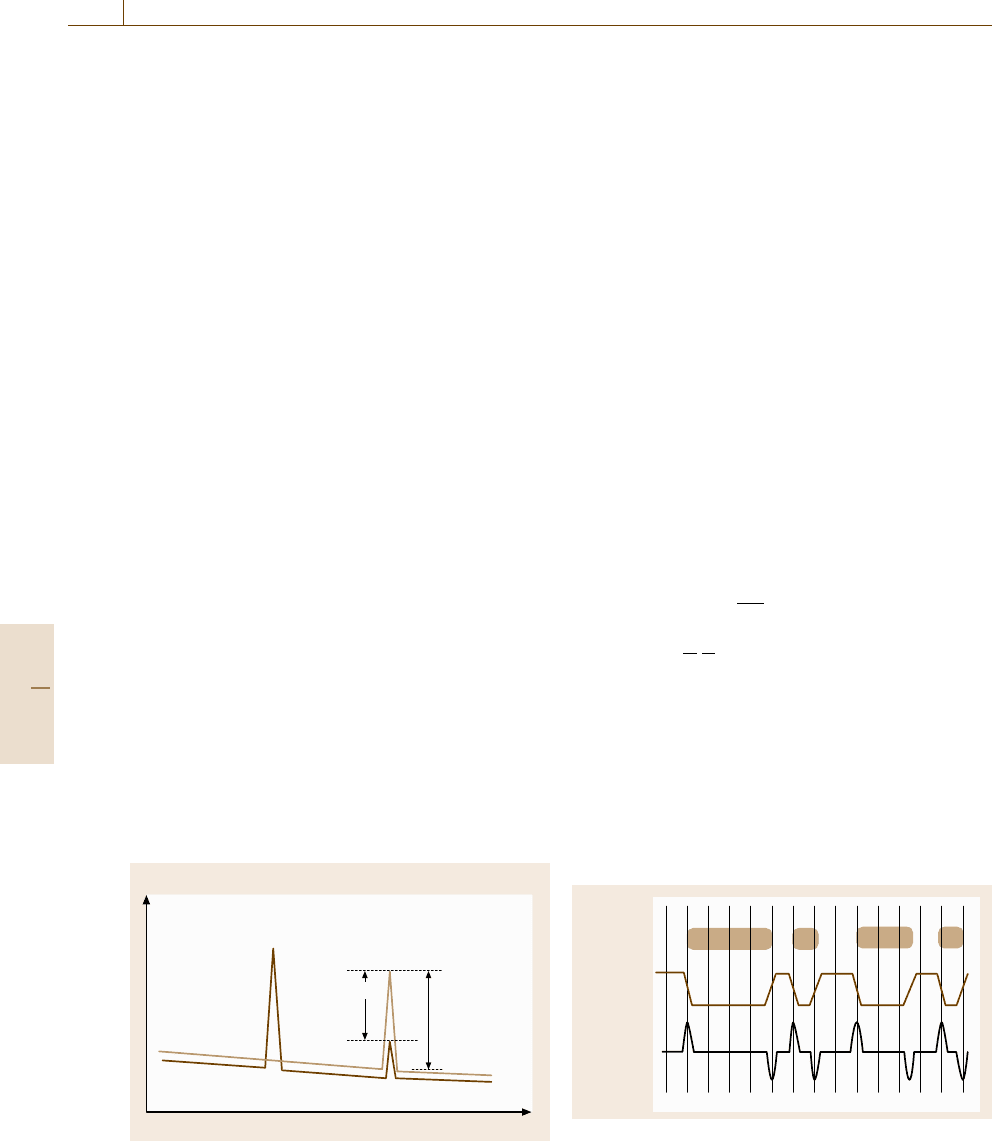
646 Part C Materials Properties Measurement
fers between the amorphous and crystalline portions;
accordingly, the recorded signals are detected as the
variation of the reflection light intensity from the op-
tical disk. The C/N ratio is determined by the ratio of
the averaged signal amplitude and the noise floor at
the frequency f
1
, as shown in Fig. 11.89. Usually, the
above operations are carried out using a spectrum meter
by stepping up the exposed laser powers, and the satu-
rated value is determined as the C/N ratio of the optical
disk. It is said that 45 dB is the usual minimum limit
for a digital recording. The laser power to achieve satu-
ration is determined by the recording power, as shown.
To rewrite the data, another monotone signal with a fre-
quency f
2
is overwritten on the recorded signal track,
and the attenuation ratio of the signal amplitude of f
1
is determined to be the erasability. It is generally said
that the erasability should be at least 20–26 dB to avoid
influencing the quality of the overwritten signal.
The signal amplitude, noise level, and erasability
are tightly related to the optical changes of the mater-
ial, film quality such as surface flatness and grin size,
and crystallization properties such as the crystallization
rate, respectively.
Jitter and BER. In recent optical disks, signal marks
with various lengths, for example from 1.5 to 4 T with
a resolution of 0.5 T (where T is the clock period)
are recorded as digital signals on an optical disk, and
information is put at every distance from a certain
mark-edge to the neighboring mark-edges. Figure 11.90
shows a schematic model of the digital recording sig-
nals. As can be seen from the figure, inhibition of the
mark-edge deviation is important for increasing sig-
nal quality; an error occurs if the deviation becomes
over half of the clock period T . To increase the record-
Signal amplitude (dBm)
Signal frequency (MHz)
f
2
f
1
Erasability
(erasing
ratio)
C/N
Fig. 11.89 Measurement scheme of C/N using spectrum
analyzer
ing density, the mark length and space length has to
be as short as possible. However, this is thermally
restricted since the phase-change mechanism is a heat-
mode process. This means that the desired thermal
conductivity of phase-change films is lower than that of
metals metals. Jitter is measured using a time-interval
analyzer.
BER is the most important index to evaluate the
disk performance for digital recording. It is measured
by comparing the source signal and readout signal one
by one. In the case of computer uses, an error rate of
10
−3
–10
−4
is the minimum level.
Reliability
Reliability is naturally one of the most important fac-
tors for industrial materials. In particular, the highest
level of reliability is intrinsically required for memory
devices. In the case of phase-change optical mem-
ory, reliability includes the thermal stability of the
amorphous state and the chemical stability of the ma-
terial itself. Both factors are usually evaluated through
accelerated environmental tests based on Arrhenius’s
equation (11.123).
K = A exp
−
E
RT
or
ln(k) =−
E
R
1
T
+ln A , (11.123)
where K, A, E, R and T are the reaction rate con-
stant, frequency factor, activation energy, gas constant
and environmental temperature, respectively.
The equation gives an estimation of the chem-
ical reaction speed at a certain temperature. It is seen
that the rate of chemical reaction becomes large as
the temperature increases. The right-hand side of the
equation means that the logarithm of K varies lin-
Recorded
marks
Optical
quantity
(reflecti-
vity)
Current
001000000010101000100001001010
T
Fig. 11.90 Schematic of the mark-edge recording-repro-
ducing method. Signal 1 is applied on positions where
reflectivity drastically changes
Part C 11.6
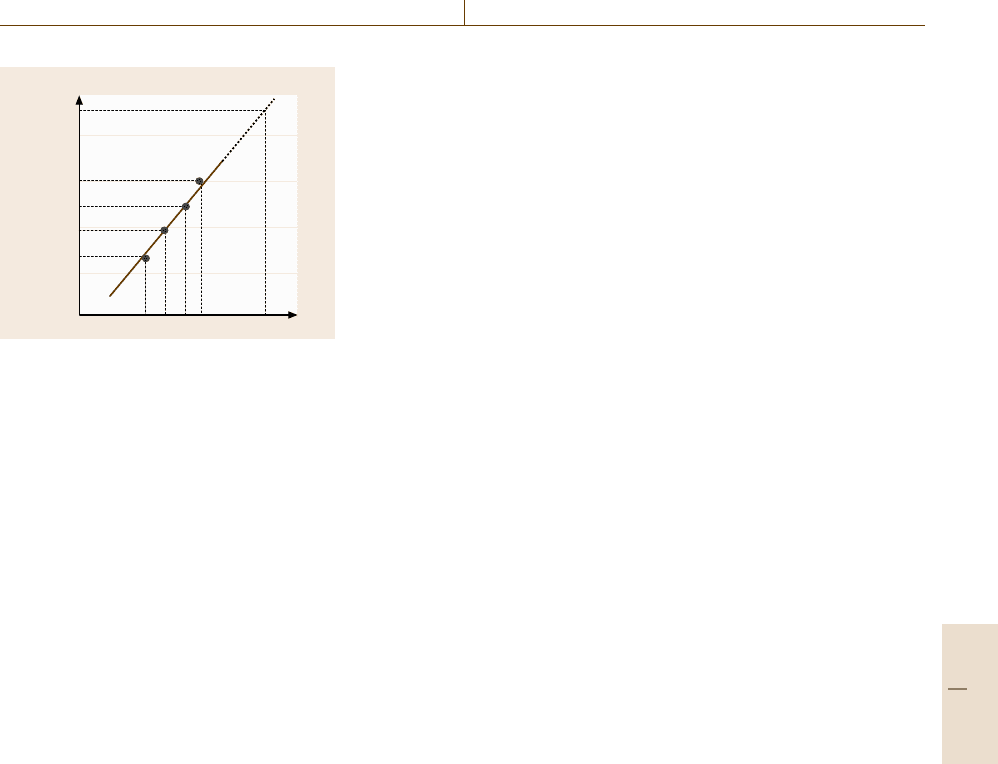
Optical Properties 11.6 Evaluation Technologies for Optical Disk Memory Materials 647
Time
1/T
r.t.
Life time
Fig. 11.91 Schematic of Arrhenius plot for obtaining an
estimated life at room temperature (r.t.) based on the Ar-
rhenius equation
early with 1/T on a logarithmic graph. Accordingly,
it is possible to obtain the activation energy for the
chemical reaction as the gradient of the straight line.
The straight line is drawn based on the least-squares
method by plotting the test results at various tempera-
tures. By extrapolating the relation to room temperature,
an estimated life under practical conditions can be
obtained.
Figure 11.91 shows a schematic example of an Ar-
rhenius plot. In the figure, the vertical axis shows the
time for −3 dB of C/N. By extrapolating the straight
line to 30
◦
C, the estimated life of this optical disk is
determined to be more than 50 years. The vertical axis
can be arbitrarily selected to BER, reflectivity, ampli-
tude and noise level etc. as required. The acceleration
condition can also be selected in a number of ways. In
the case of optical disks, the acceleration test is usually
carried out under high-humidity conditions such as 70
or 80% RH in order to evaluate moisture resistance.
11.6.2 Evaluation Technologies
for MO Materials
To evaluate magnetooptical memory materials, the in-
vestigation of their magnetic characteristics is the most
important. Of course, thermal and optical properties are
not disregarded; however, broadly speaking, these pa-
rameters are only important in relation to the magnetic
properties. Items that are common to the phase-change
technologies are omitted here.
R&D History of MO Materials
Research into MO recording was started by Williams
in 1957 [11.177]. He recorded a signal on an MnBi
magnetic film using a magnetic pen and observed the
recorded magnetic domain based on the MO effect.
The following year, Mayer formed similar magnetic
domains using a thermal pen. This fact became the ori-
gin of so-called thermal-magnetic recording [11.178].
There was a short break before Chang first reported
thermal-magnetic recording using a laser beam in 1965.
This became the prototype of present MO record-
ings [11.179]. From that point, various studies have
been carried out to search for memory materials suitable
for MO recording. Finally, in 1973, Chaudhari et al.
found a good MO material based on the rare-earth
transition-metal (RE-TM) system [11.180]. It is known
that the RE-TM material system has the following su-
perior characteristics
1. the film noise is intrinsically low since the film is
used in its amorphous state,
2. the perpendicular magnetization is easily formed,
and a large MO effect is obtained,
3. a plastic substrate can be adopted since it does not
require thermal treatment, and
4. the recording properties can be freely optimized
since it is a ferrimagnetic material.
Today, various RE-TM materials are formed com-
bining from heavy-earth elements such as Ge, Tb
and Dy and the transition-metal elements Co and Fe.
These have been adopted for the memory layer of all
the commercialized MO disks without exception. RE-
TM materials are characterized by their magnetically
continuous structure, as opposed to the gradual struc-
ture of usual magnetic materials used in their crystal
state.
Evaluation and measurement methods for MO
technology are described below, as relevant to their ap-
plication to RE-TM materials for memory layers.
Principle of MO Recording
The principle of MO recording is explained us-
ing Fig. 11.92. Before recording, the direction of the
perpendicular magnetization is aligned to one direc-
tion by globally applying an intense magnetic field. At
this time, the film is instantly heated, which is usually
achieved with a flash lamp. The MO film has a large
coercive force and a very intense magnetic field is nec-
essary to change the direction of the magnetic field
at room temperature. However, the coercive force of
a magnetic material is lowered when the film temper-
ature is increased.
Utilizing this phenomenon, we use both a laser
beam and an external magnetic field for recording. One
Part C 11.6
